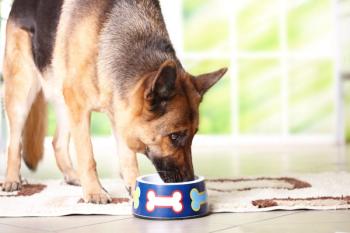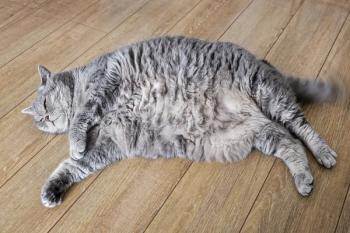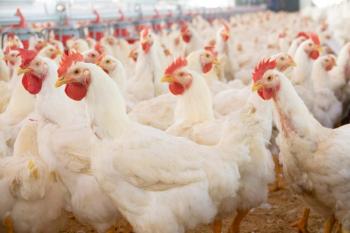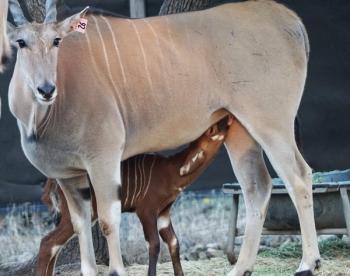
Diagnosing and treating gastric ileus/stasis in rabbits (Proceedings)
Because practitioners are increasingly being asked to provide health care for rabbits, they need to know that the most common clinical problems seen in this species involve the gastrointestinal tract. Practitioners also need to know that rabbits have evolved as a prey species, and their survival reaction is to be very still in an effort to avoid detection.
Because practitioners are increasingly being asked to provide health care for rabbits, they need to know that the most common clinical problems seen in this species involve the gastrointestinal tract. Practitioners also need to know that rabbits have evolved as a prey species, and their survival reaction is to be very still in an effort to avoid detection. If this strategy is unsuccessful, rabbits can have rapid bursts of speed to avoid capture. These behaviors also "carry-over" in most domestic rabbits, and may result in an animal appearing stoic when stressed. Stressed animals are more susceptible to health problems, which initially result in anorexia and changes in the frequency and consistency of their pellets.
Anatomy
The abdominal cavity of rabbits is large, with the gastrointestinal tract being relatively long, and its contents can make up 10-20% of the body weight. The stomach typically contains 15% of the alimentary tract ingesta and serves as a reservoir for much of the ingested feed. The cardia and pylorus are well developed. Rabbits are unable to vomit because of the enteric arrangement of their cardia and stomach, and their pylorus is easily compressed by the duodenum, which exits at an acute angle. Gastric distention or compression due to a fur-ball, gas, or hepatomegaly contributes to pyloric compression and prevents emptying.
The small intestine is shorter in rabbits than in other species, and makes up about 12% of the gastrointestinal tract volume. The terminal portion of the ileum ends in the cecum and is expanded as the rounded sacculus rotundus (a common site of foreign body impaction). The rabbit's large, thin-walled, coiled cecum holds about 40% of the ingesta. This structure ends in a thick-walled, vermiform appendix that is characterized, like the sacculus rotundus, by lymphatic tissue. The cecum is the largest and most prominent organ of the abdominal cavity. Sacculations and bands characterize the colon, which starts from an area of the cecum known as the ampulla coli.
Digestive physiology
Following is a brief outline of some of the characteristics of rabbit digestive physiology:1-3
1. Rabbits are herbivorous and their gastrointestinal system combines a simple stomach with hindgut cecal fermentation to efficiently ingest large quantities of poorly digestible fiber that is essential for normal peristalsis.
2. Dietary fiber primarily stimulates gut motility rather than serves as a source of nutrition.
3. Rabbit teeth are developed for a high-fiber, herbivorous diet. Chewing is characterized by up to 120 jaw movements per minute with a lateral motion, which helps keep the constantly growing teeth worn down.
4. Normal peristaltic movements propel the larger, less dense fiber particles through the colon, while reverse peristalsis of the haustra of the colon move the fluid and small particles (the higher density components) retrograde to the cecum. Small particles and fluid are retained in the cecum, allowing for extensive fermentation.
5. Cecal contents are expelled at intervals and consumed directly from the anus (cecotrophy). The cecotrophes have an outer greenish membrane of mucus that encloses semiliquid cecal ingesta; they contain high levels of vitamins B and K and twice the protein and half the fiber of hard feces.
6. The most common cecal bacteria are anaerobic, gram-negative bacilli in the genus Bacterioides and large anaerobic metachromatic staining bacteria. Large ciliated protozoa are also present.
7. Consumed microorganisms do not normally reach and infective dose in the small intestine because they succumb to the stomach's low pH of 1-2. When a rabbit's gastrointestinal system is compromised, common rabbit enteropathogens can "overgrow", and become invasive and produce toxins.
Nutrition
Rabbits require large amounts of fiber in the diet (15-16% crude fiber) to promote intestinal motility and minimize intestinal disease. Diets low in fiber promote an increased incidence of intestinal problems such as hypomotility and prolonged cecal retention time, causing reduced feed intake and predisposition to diarrhea. Coarse, nondigestible particles stimulate normal gastrointestinal processes including secretion, digestion, absorption, peristalsis, and excretion. Normal peristalsis occurs with the ingestion of a high-fiber diet, which provides a large particle size and which results in a lattice-like food ball for effective gastric acid penetration. Incomplete penetration of foods with small particles by gastric acid may result in the production of hard-packed food balls, especially in rabbits with marginal water consumption.
The preferred diet for the pet rabbit is a high quality, high fiber (15-16% crude fiber) pelleted diet containing 13-18% (ideally 16%) crude protein, at the rate of ¼ cup pellets per 2.3 kg body weight divided into two meals per day. A fiber content below 15% may increase the potential for anorexia and diarrhea, and one over 16% reduces feed palatability. However, a fiber content of 18-22% appears to help prevent obesity in pet rabbits and is useful for long-term use in mature laboratory animals. Because it is generally lower in protein and calcium and higher in fiber, grass hay (timothy, prairie, oat, etc.) is recommended over legume hay (i.e., alfalfa) for mature pet rabbits. Pelleted diets formulated from timothy hay (i.e., Bunny Basics/T, Oxbow Pet Products, Murdock, NE) are commercially available for adult pet rabbits. These diets are intended to help prevent obesity, urolithiasis or urinary "sludge," and gastric stasis.
Some rabbits do well, though, when pellets are offered ad libitum, unless overeating and obesity become problems or unless an adequate amount of loose hays are not consumed. The pellets are supplemented with loose hay (mixed grass hay, timothy hay, or high quality dried grass clippings) and provided ad libitum. Alfalfa hay can be offered throughout the growth stages, then discontinued because of its high protein and calcium content. The diet can be supplemented with a small amount (up to one cup) of dark fibrous, leafy greens (kale, mustard greens, carrot tops, parsley, or dandelion greens) and fresh vegetables (carrots, broccoli, green peppers, cauliflower, or cabbage) per 2.3 kg body weight daily or several times per week. In addition, rabbits can receive a small amount (up to one tablespoon per 2.3 kg body weight) of fresh fruit (strawberries, other berries, apples) daily or several times per week. It should be noted that growing rabbits and females in late gestation may require twice as much food as an adult rabbit at maintenance; lactating does may consume three times as much food as an adult in maintenance.
Gastric stasis/ileus
Trichobezoars (hairballs, fur balls, "wool block") are masses of hair that occur commonly in the stomachs of mature rabbits. The prevalence of masses of hair retained within rabbits' stomachs is unknown, but hairballs are a common clinical entity in the stomachs of normal healthy rabbits. Although trichobezoars are the common terms used to describe these cases, the terms gastric stasis or gastrointestinal hypomotility/ileus to better reflect the clinical condition. These terms are probably appropriate, especially because this syndrome has occurred in some rabbits that have not ingested large amounts of hair, but rather the material in the stomach consisted primarily of ingested foods.
Although factors leading to hairball formation/gastric stasis/ileus are multifactorial, the major factor contributing to their accumulation in rabbits appears to be the low fiber diet provided many rabbits.4 Contributing factors to trichobezoars include the fact that rabbits have a small and relatively nondistensible, but well-developed muscular pyloric sphincter, an inability to vomit, and the habit of commonly consuming hair during grooming activities. In addition, other factors that contribute to gastric stasis/ileus include stress (psychological triggers), pain (i.e., molar spurs), disease (i.e., hepatic, renal), or gastrointestinal blockage.
History and clinical signs
Gastric stasis/ileus is most commonly characterized by anorexia (frequently of 2-7 days' duration), oligodipsia, reduced number of fecal pellets (and those that are passed are smaller than normal or may contain hair) or a lack of fecal production, and a large stomach filled with dough-like contents. The rabbit may be alert or depressed and may have lost weight, depending on the chronicity of the problem and the hydration status. Some animals may be hunched over, grind their teeth, and have abdominal tenderness, all evidence of pain. In some cases, diarrhea may be present at some stage of the disease. History of the rabbit may also reveal: a high carbohydrate, low fiber diet; excessive grooming and ingestion of hair (especially during the shedding season); boredom; and a stressful environment.
In acute pyloric obstruction, severe depression, lethargy, bloating, dehydration, hypothermia, and shock may occur. Death can result from prolonged anorexia and metabolic imbalance if the obstruction is not removed or the stasis/ileus corrected, and hepatic lipidosis is a commonly associated lesion.
Diagnosis
Although diagnosis of gastric stasis/ileus in rabbits is generally made on the basis of history, clinical signs, physical examination, and results of abdominal radiographs, a definitive diagnosis can be difficult in some cases. Generally, a complete blood count and serum chemistry analysis are conducted to assess the overall condition of the patient and to help rule out other causes of the clinical signs, which are generally nonspecific. Definitive diagnosis of trichobezoar/gastric stasis/ileus/obstruction, however, can also be made with exploratory laparotomy.
Treatment
Most rabbits with gastric stasis/ileus respond to aggressive medical management consisting of parenteral fluids, force feeding and rehydration of the stomach contents, and stimulation of gastrointestinal motility by administering a high fiber diet and gastrointestinal promotility agents.5-7
Subcutaneous administration of isotonic fluids (i.e., lactated Ringer's solution) helps to improve and maintain hydration. Although the daily fluid requirements of a rabbit is approximately 120 ml/kg, administering 50-60 mg/kg/day may be adequate in mild or moderately ill rabbits in conjunction with per os fluids. Although seldom needed, placement of an intravenous catheter in the cephalic vein or an intraosseous catheter in the proximal femur or tibia can also be used to hydrate the patient.
Force-feed Critical Care for Herbivores (Oxbow Pet Products) or blenderized alfalfa pellets in water or electrolyte solution (i.e., Pedialyte®, Ross, Columbus, OH), is extremely important in not only providing nutrients and fiber, but in rehydrating both the rabbit and its hairball, and may improve the passage of excess hair through the gastrointestinal tract. Some practitioners have also used mixed-vegetable and/or fruit baby foods or a human enteric feeding formula for short term use. Anorectic rabbits can be syringe-fed 10-15 ml/kg (or as much food as they will comfortably take) q8-12h. In addition, always provide the patient access to fresh greens (parsley, romaine lettuce, carrot tops, kale, cilantro, collard greens, etc.), vegetables, small amounts of fruit, hay (ie, timothy, clover, grass, or alfalfa), pellets, and fresh water. Vitamin supplements (especially vitamin B) also can be administered.
Broad-spectrum antibiotics (i.e., enrofloxacin [5-10 mg/kg PO q12h], trimethoprim-sulfa [30 mg/kg PO q12h], or metronidazole [20 mg/kg PO q12h]) have also been used, but response to treatment is difficult to assess. Cholestyramine (Questran, Bristol Laboratories) (2 g in 20 ml PO q8-24h), an ion-exchange resin that binds clostridial iota toxins,8 has been used for 18-21 days in treating/preventing enterotoxemia. Analgesics (i.e., buprenorphine at 0.01-0.05 mg/kg SC, IM, IV q8-12h or meloxicam at 0.5 mg/kg SC, IM q24h) and/or simethicone (65-130 mg q1h x 2-3 doses) may reduce abdominal discomfort. Intestinal pain from gas distension and ileus impairs motility and decreases appetite, and may inhibit recovery.8 Motility modifiers (cisapride at 0.5 mg/kg PO q8-12h) may be helpful in rabbits with gastrointestinal hypomotility; cimetidine (5-10 mg/kg PO, SC, IM, IV q6-12h) and ranitidine (2 mg/kg IV q24h or 2-5 mg/kg PO q12h) may ameliorate or prevent gastric ulceration. Metoclopramide (0.5 mg/kg PO, SC q6-8h) has been used as a gastrointestinal promotility agent; efficacy is questionable.8 Because rabbits are very sensitive to corticosteroids and because these drugs may exacerbate subclinical bacterial infections, corticosteroids are not generally indicated for use in this species. Other treatments for gastric stasis/ileus include exercising the rabbit, abdominal massage, and feeding the patient cecotropes from a healthy rabbit. Brushing the hair may be useful to prevent exacerbation of the problem, and supplemental heat may be required in cases of hypothermia. Rabbits with gastric stasis/ileus should be kept in a warm, quiet environment, and generally recover more quickly when (and if) they can be treated at home.
In addition to the aforementioned strategies for treating a rabbit with gastric stasis/ileus, it is always important to identify and treat/correct underlying medical problems (i.e., hepatic or renal disease) or other causes of the condition. On rare occasions, the mass of material in the stomach is so dehydrated that the rabbit fails to respond to medical treatment, and surgical intervention is necessary. However, the prognosis for a successful outcome is greatly reduced in patients requiring a gastrotomy.
Prevention
Prevention of gastric stasis/ileus in rabbits is best accomplished by feeding high-fiber, high quality diets because the increased fiber component stimulates gastrointestinal motility, thereby decreasing hair accumulation. Also, avoiding stress and obesity and reducing boredom through environmental enrichment are reasonable recommendations for prevention. In addition, owners should be encouraged to brush their rabbits frequently to remove excess hair to further reduce the occurrence of trichobezoar formation. Brushing may help prevent, but will not eliminate, trichobezoar formation in both long- and short-haired rabbits. Access to blankets and carpets which may be ingested should be eliminated.
References
1. Brooks, D.L. 2004. Nutrition and gastrointestinal physiology. In: Quesenberry, K.E., J.W. Carpenter, eds. Ferrets, Rabbits, and Rodents: Clinical Medicine and Surgery. 2nd ed. Philadelphia, WB Saunders, pp. 155-160.
2. Donnelly, T.M. 2004. Basic anatomy, physiology, and husbandry. In: Quesenberry, K.E., J.W. Carpenter, eds. Ferrets, Rabbits, and Rodents: Clinical Medicine and Surgery. 2nd ed. Philadelphia, WB Saunders, pp. 136-146.
3. Irlbeck, N.A. 2001. How to feed the rabbit (Oryctolagus cuniculus) gastrointestinal tract. J. Anim. Sci. 79:E343-E346.
4. Reusch, B. 2005. Rabbit gastroenterology. Vet. Clin. N. Am.: Exotic Anim. Pract. 8:351-375.
5. Carpenter, J.W. 2004. Management of trichobezoars/gastric stasis in rabbits. In: Bonagura, J.D., ed. Kirk's Current Veterinary Therapy XIII: Small Animal Practice. Philadelphia, WB Saunders, pp. 1140-1144.
6. Carpenter, J.W., ed. 2005. Exotic Animal Formulary. 3rd ed. St. Louis, Elsevier Saunders, pp. 409-444.
7. Jenkins, J.R. 2004. Gastrointestinal diseases. In: Quesenberry, K.E., J.W. Carpenter, eds. Ferrets, Rabbits, and Rodents: Clinical Medicine and Surgery. 2nd ed. Philadelphia, WB Saunders, pp. 161-171.
8. Oglesbee, B. 2006. The 5-Minute Veterinary Consult: Ferret and Rabbit. Ames, IA, Blackwell Publishing, pp. 207-209, 259-261, 266-269, 367-370.
Newsletter
From exam room tips to practice management insights, get trusted veterinary news delivered straight to your inbox—subscribe to dvm360.






